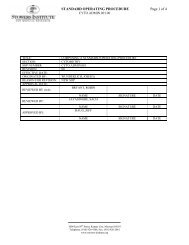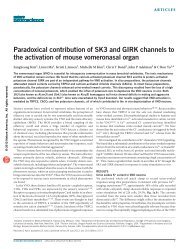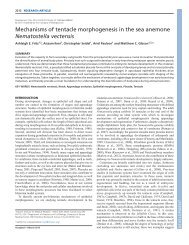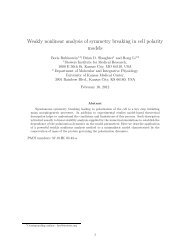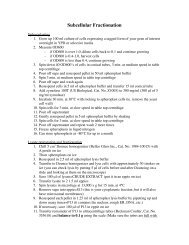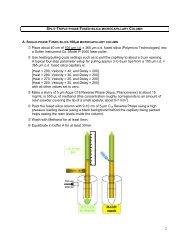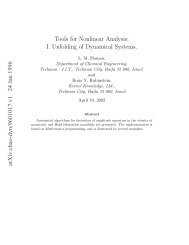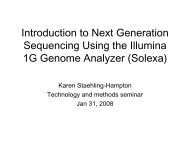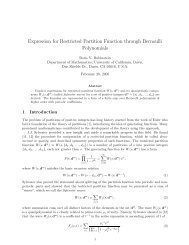Computer Tools for Bifurcation Analysis: General Approach with
Computer Tools for Bifurcation Analysis: General Approach with
Computer Tools for Bifurcation Analysis: General Approach with
Create successful ePaper yourself
Turn your PDF publications into a flip-book with our unique Google optimized e-Paper software.
<strong>Computer</strong> <strong>Tools</strong> <strong>for</strong> <strong>Bifurcation</strong> <strong>Analysis</strong> 987<br />
2.2. Monotonic bifurcation<br />
2.2.1. Fold bifurcation<br />
A monotonic bifurcation is also a bifurcation of<br />
equilibria of the dynamical system (1). Setting u 1<br />
= const, i.e. ∂ 0 u 1 = 0, allows to find a shift of<br />
the stationary solution due to small variations of<br />
parameters<br />
u 1 = −fu −1 f R R 1 . (7)<br />
The n × m array fu<br />
−1f<br />
R is recognized as the parametric<br />
sensitivity matrix. Continuous dependence<br />
on parameters can be used to construct a branch of<br />
equilibria which terminates at a bifurcation point<br />
R 0 .<br />
On a monotonic bifurcation manifold, the matrix<br />
f u has no inverse. This means that one can<br />
neither construct a stationary solution at values of<br />
parameters close to this point, nor characterize the<br />
stability of the equilibrium in the linear approximation.<br />
The dynamics in the vicinity of the bifurcation<br />
manifold is governed by a nonlinear amplitude<br />
equation to be obtained in higher orders of the<br />
expansion.<br />
Generically, the zero eigenvalue is nondegenerate.<br />
Let U be the corresponding eigenvector satisfying<br />
f u U =0. Then<br />
u 1 =a(t 1 ,t 2 ,...)U (8)<br />
is the solution of Eq. (6) that remains stationary<br />
on the fast time scale t 0 . The amplitude a is so<br />
far indeterminate, and can depend on slower time<br />
scales.<br />
The inhomogeneous equation (5) has solutions<br />
constant on the rapid time scale, provided its inhomogeneity<br />
does not project on the eigenvector U.<br />
This condition is<br />
κ 1 ≡ U † f R R 1 =0, (9)<br />
where U † is the eigenvector of the transposed matrix<br />
f u † = Transpose[f u ] satisfying f u † U † =0;weassume<br />
that the eigenvector is normalized: U † U =1.<br />
Equation (9) defines the tangent hyperplane to the<br />
bifurcation manifold at the point R = R 0 .<br />
Be<strong>for</strong>e writing up the second-order equation,<br />
we require that the second-order deviation u 2 remain<br />
constant on the rapid time scale (otherwise it<br />
might outgrow u 1 at long times). The dependence<br />
upon slower time scales must be expressed exclusively<br />
through the time dependence of the amplitude<br />
a. Using Eq. (8), we write the second-order<br />
equation as<br />
f u u 2 = ∂ 1 aU − f R R 2 − af uR UR 1 − 1 2 a2 f uu UU .<br />
(10)<br />
The solvability condition of this equation is<br />
∂ 1 a = κ 2 + λ 1 a + µ 0 a 2 . (11)<br />
The parameters of Eq. (11) are<br />
κ 2 = U † f R R 2 + 1 2 U† f RR R 1 R 1 ,<br />
λ 1 = U † f uR UR 1 ,<br />
µ 0 = 1 2 U† f uu UU .<br />
(12)<br />
The indices correspond to the scaling of respective<br />
parametric deviations from the bifurcation point.<br />
In a generic case, one can consider only parametric<br />
deviations transverse to the bifurcation manifold,<br />
and set R 1 = 0 to satisfy Eq. (9); then λ 1 =0,and<br />
generic equation <strong>for</strong> slow dynamics near the bifurcation<br />
manifold becomes<br />
∂ 1 a = κ 2 + µ 0 a 2 . (13)<br />
This equation can be also obtained by shifting the<br />
amplitude in Eq. (11). On the one side of the bifurcation<br />
manifold, where κ 2 has the sign opposite<br />
to that of µ 0 , there are two stationary states<br />
a = ± √ −κ 2 /µ 0 . When viewed as a solution of<br />
Eq. (13), one of them is stable, and the other, unstable.<br />
The stable solution corresponds to a stable<br />
equilibrium of the original system Eq. (1), provided<br />
the rest of eigenvalues of the matrix f u have negative<br />
real parts. On the other side of the bifurcation<br />
manifold, where the signs κ 2 and µ 0 are the same,<br />
there are no stationary states. The trajectory of<br />
the dynamical system is deflected then to another<br />
attractor, far removed from u 0 . Thus, the system<br />
undergoes a first-order phase transition when the<br />
bifurcation manifold is crossed. If the value of some<br />
dynamic variable or other characteristic of the solution<br />
is drawn as a function of parameters, the bifuration<br />
locus can be seen as the projection of a fold of<br />
the solution manifold on the parametric plane; accordingly,<br />
the generic monotonic bifurcation is also<br />
called a fold bifurcation.<br />
2.2.2. Transcritical bifurcation<br />
It may happen that the matrix f R as well the tensor<br />
f RR vanish identically. This would be the case when<br />
u 0 is a “trivial” solution that remains constant at




